Sales Forecasting: Supply & Demand
A common mistake made by sales leaders when building out a sales forecast is only considering the "supply-side" of their forecasting model.
That is, the model will include some version of the following inputs:
# of Reps
Quota
Discount on quota
Ramp-up time
Rep turnover rate
They'll put all of those inputs into a spreadsheet and come up with a projection.
This is a crucial step in the process. If you want to generate $100 million in revenue, you need a model that will tell you how many reps you'll need to hire; e.g what is the "supply" of reps you need to get to your number?
But this is only half of the equation. The other half of the equation is the demand-side. You have enough reps to sell $100 million but is there enough market demand to sell $100 million? If there isn't enough demand, you now have two problems: 1/ you're not going to hit your number and 2/ you have too many reps.
To avoid that outcome, a sales leader must put an equal amount of energy into the demand-side of the model. Typically, that will include these inputs:
Total addressable market (TAM): this is the number that you could hit if you sold to every potential buyer of your product in the current period.
Serviceable addressable market (SAM): this is the number you could hit if you sold to every potential buyer in the markets that you serve in the current period. For example, if your product is only live in half of the U.S. market your SAM would be 50% of TAM. This could also be limited by specific verticals or buyer types that you’re currently servicing.
Serviceable Obtainable market (SOM): this is the amount SAM that you can realistically obtain. Because of competition, delivery constraints, etc. you're not going to be able to sell 100% of SAM.
So, in order to be comfortable that there's enough market demand to get to $100 million, your SOM must exceed $100 million. There's no doubt that great salespeople and great sales teams can create demand that isn't there, but this doesn't scale and it’s a dangerous assumption to make. It’s crucial that sales leaders understand the actual market demand for the products they’re selling as it exists today.
The demand-side of the model is often more difficult to calculate than the supply-side because it's generally harder to understand and control — particularly in the early days. But there's a long line of sales leaders that made the mistake of not paying enough attention to demand and thus over-hired and missed their numbers. That’s the kiss of death for any sales leader. Applying equal rigor to both the supply-side and the demand-side of a sales forecast is the best way to avoid that outcome.

